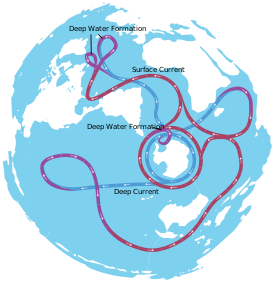Latest revision as of 17:59, 4 March 2022
Information about message (contribute ) This message has no documentation.
If you know where or how this message is used, you can help other translators by adding documentation to this message.
Message definition (AY Honors/Oceans/Answer Key )
</noinclude>
</noinclude>
<!-- d. On a blank world map, sketch the global conveyor belt.<br />i. Use a blue writing utensil to represent the cold dense currents.<br />ii. Use a red writing utensil to represent the warm less dense currents.<br />iii. Label the oceans that the global conveyor belt passes through. -->
[[File:Conveyor belt.svg|thumb|left|275px|link={{filepath:thermohaline_circulation.svg}}|''The global conveyor belt on a continuous-ocean map [{{filepath:thermohaline_circulation.svg}} (animation)'']]]
The current begins near the North Pole getting warmer as it travels south around South America eventually coming to Antarctica where it picks up cold water again. It then splits, one part traveling to the Indian Ocean and the other to the Pacific Ocean. As these currents reach the equator, they get warmer and eventually make their way back around South America and up in the North Atlantic Ocean where the cycle starts again. The water moves quite slowly at about 10 cm per second. It can take up to 1000 years for water in the North Atlantic to end up in the North Pacific!
<noinclude> The global conveyor belt on a continuous-ocean map (animation) The current begins near the North Pole getting warmer as it travels south around South America eventually coming to Antarctica where it picks up cold water again. It then splits, one part traveling to the Indian Ocean and the other to the Pacific Ocean. As these currents reach the equator, they get warmer and eventually make their way back around South America and up in the North Atlantic Ocean where the cycle starts again. The water moves quite slowly at about 10 cm per second. It can take up to 1000 years for water in the North Atlantic to end up in the North Pacific!

